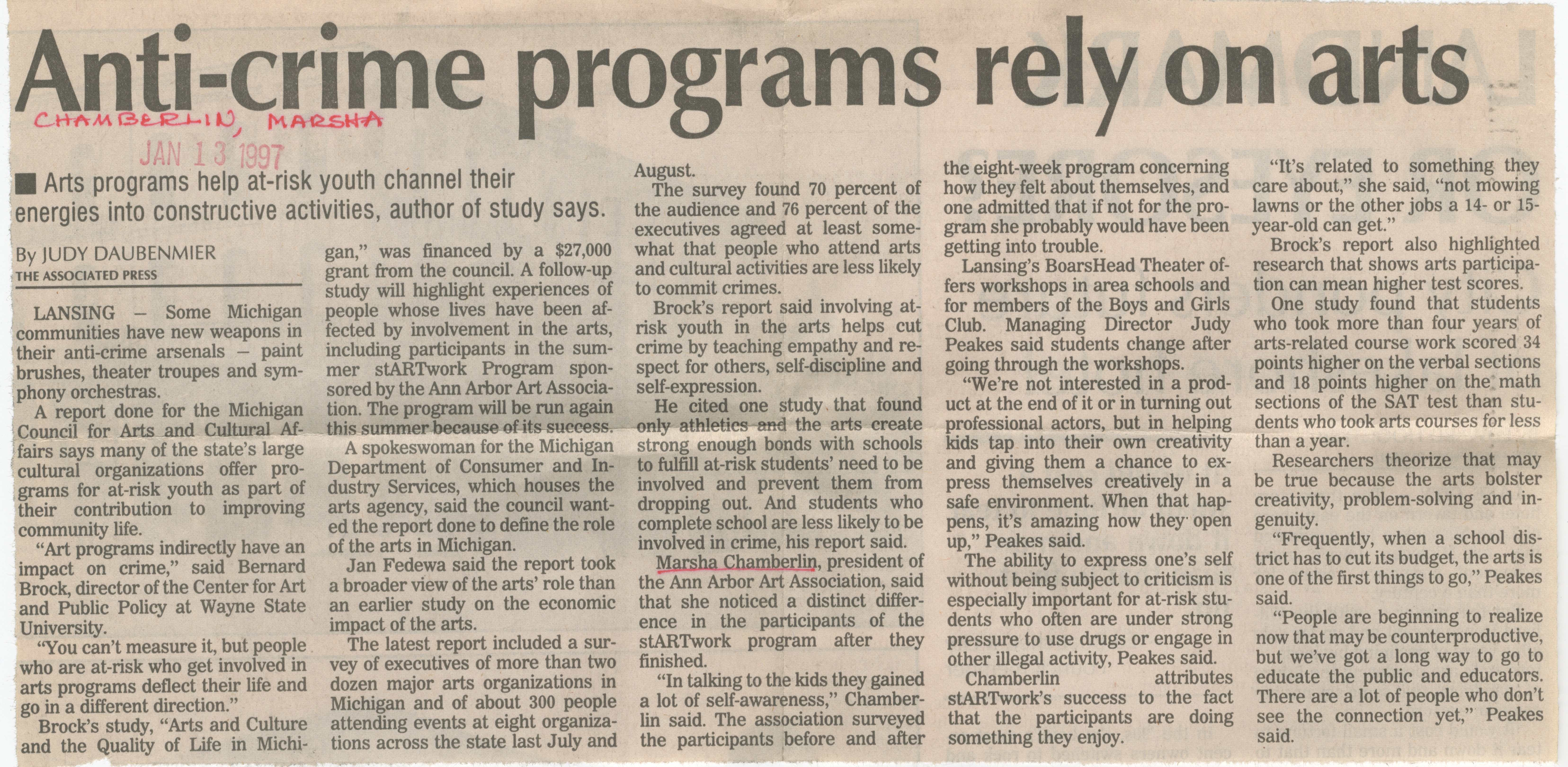Anti-crime programs rely on arts

Anti-crime programs rely on arts
c^^^Ofcsz^iiu r^A^sw^ I ^J / :
• Arts programs help at-risk youth channel their
energies into constructive activities, author of study says.
ByJUDYDAUBENMIER
THE ASSOCIATED PRESS
LANSING - Some Michigan
es have new weapons in
ti ^«n crime arsenals - paint
ushes, theater troupes and sym-
phony orchestras.
A report done for the Michigan
' " •rts and Cultural Af-
of the state's large
r pro-
part of
lion to improving
"Art programs indirectly have an
impact on crime/' said Bernard
Brock, director of the Center for Art
anc? ^ ' 1 c Policy at Wayne State
Un , ,,.
"You can't measure it, but people
who are at-risk who get involved in
arts progra ct their life and
go in a differs. election."
Brock's study, "Arts and Culture
and the Quality of Life in Michi-
^nnnced by a $27,000
)uncil. A follow-up
gan, wa?" ^n:
grant fro;
study will highlight experiences of
people whose lives have been af-
fected by involvement in the arts,
including participants in the sum-
mer stARTwork Program spon-
sored by I1'80 Ann ^or Art Associa-
tion. The ii be run again
this summer because
A spokeswoman for the Michigan
Departm^ ' ^ nw^umer and In-
dustry Si h houses the
arts ager want-
ed the re| -^••- ^>w:im- ';ierole
of the arts in Michigan.
Jan Fedewa said the report took
a broader view of the arts' role than
an earlier study on the economic
impact of the arts.
The la' )ort included a sur-
vey of ex s of more than two
dozen major arts on? ms in
Michigan and of aboi people
attending events at eight organiza-
tions across the state last July and
August.
The sun d 70 percent of
the audience ^.lO <6 percent of the
executives agreed at least some-
what that people 'vbo attend arts
and cultural act re less likely
to commit crimes.
Brock's report said involving at-
risk youth in the arts helps cut
crime by teaching empathy and re-
spect for others, self-discipline and
self-expression.
He cited one study that found
only ^^^^ wSi the arts create
siron, i bonds with schools
to fulfill ai-nssk students' need to be
involved and prevent them from
dropping out. And students who
complete school are less likely to be
involved in crime, his re d.
MM^ha Chamherlin, p it of
the Ann Arbor Art Association, said
that she noticed a distinct differ-
ence in the participants of the
stARTwork program after they
finished.
"Inf -'^- •;•:n-•.T;^l^.nii-l';iined.
a lot o. ,-.. r t.,.,n,-,....,.,.. . ^;.i,ber-
lin said. The association surveyed
the participants before and after
the eight-week program concerning
how they felt about themselves, and
one admitted that if not for the pro-
gram she probably would have been
getting into trouble.
Lansing's BoarsHead Theater of-
fers workshop:- in area schools and
for mem the Boys and Girls
Club. Managing Director Judy
Peakes said students change after
going through the workshops.
"We're not interested in a prod-
uct at the end of it or in turning out
professional actors, but in helping
kids tap into their own creativity
and giving them a chance to ex-
press themselves creatively in a
safe environment. When that hap-
pens, it's amazing how they open
up," Peakes said.
The ability to express one's self
without being sul ' criticism is
especially important .u- at-risk stu-
dents who often are under strong
pressure to use drugs or engage in
other illegal activity, Peakes said.
C1 ;r L " attributes
stA nccess to the fact
that the participants are doing
something they enjoy.
"It's related to something they
care about," she said, "not mowing
lawns or the other jobs a 14- or 15-
year-old can get."
Brock's report also highlighted
research that shows arts participa-
tion can mean higher test scores.
One study found that students -
w* t k more than four years of
y ed course work scored 341
points higher on the verbal sections
and 18 points higher on the; math
sections of the SAT test than stu-
dents who took arts courses for less
than a year. ^
Researchers theorize that may
be true because the arts
creativity, problem-solving and in-
genuity.
"Frequently, when a school dis-
trict has to cut its budget, the arts is
one of the first things to go," Peakes
said.
"People are beginning to realize
now that may be counterproductive,
but we've got a long way to go to
educate the public and educators.
There are a lot of people who don't
see the connection yet," Peakes
said.
Article
Subjects
Ann Arbor Art Center
Ann Arbor Art Association
Art & Artists
Nonprofits
Michigan Council for the Arts
Wayne State University Center for Art and Public Policy
Startwork
BoarsHead Theater
Boys and Girls Club
Art Education
Ann Arbor News
Old News
Bernard Brock
Jan Fedewa
Marsha Chamberlin
Judy Peakes